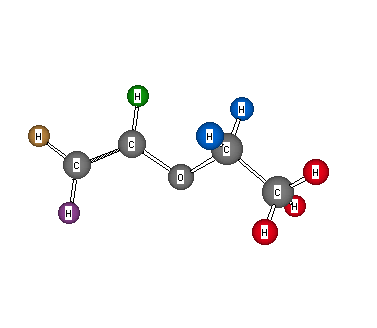Formula: C4H8O
Answer: Ethyl vinyl ether
Chemical Shift Assignments:
1H NMR: δ 1.27 (t, 3H, J = 7.2 Hz), 3.72 (quartet, 2H, J = 7.2 Hz), 3.95 (dd, 1H, J = 6.8 and 1.6 Hz), 4.14 (dd, 1H, J = 14.4 and 1.6 Hz), and 6.43 (dd, 1H, J = 14.4 and 6.8 Hz)
13C NMR: 151.8, 86.2, 63.5 and 14.6 ppm
The formula indicates one degree of unsaturation. The signals at δ 1.27 and 3.72 in the 1H NMR spectrum comprise an ethyl pattern with an attachment to a heteroatom-- namely, oxygen. All that remains of the formula after C2H5O- is C2H3. The chemical shifts (δ 3.95, 4.14, and 6.37 ) as well as their mutual pairs of coupling constants require of the remaining three proton signals constitute a vinyl pattern. Thus, C2H5O- and CH2=CH- gives ethyl vinyl ether. The J values of the hydrogens of the double bond are: trans: 14.4 Hz, cis: 6.8 Hz, geminal: 1.6 Hz. The more shielded of the two vinyl carbons (86.2 ppm) is the terminal one. Consider the effect of resonance on electron density. The 1H NMR spectra of ethyl acrylate and ethyl vinyl ether are quite similar. In particular, the chemical shifts of the terminal, geminal hydrogens of the respective vinyl groups are quite different. Use resonance concepts to rationalize these differences.
For an overlay 1H NMR spectum of ethyl acrylate and ethyl vinyl ether, click here. Return to Menu.
For an overlay 13C NMR spectum of ethyl acrylate and ethyl vinyl ether, click here. Return to Menu.
 |
oxygen-yellow |
|---|